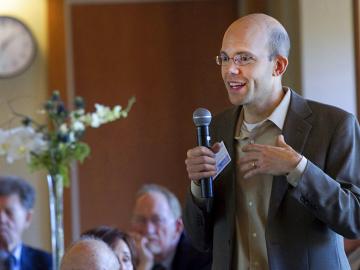Professor Don Moore has a PhD in organizational behavior from Northwestern University and is the Lorraine Tyson Mitchell Chair in Leadership and Communication at UC Berkeley Haas School of Business. In much of his published research, Dr. Moore examines overconfidence in decision-making, negotiation, and ethical choice. His psychological approach to people thinking too highly of themselves gives insight into how people make decisions, and what overconfidence means for businesses and markets. He recently sat down with Berkeley Executive Education to discuss our Executive Decision Making program and the psychological influences that bias good decision-making skills in both our personal and professional lives.
What is the biggest challenge or fear most people face when making a decision? How does one’s confidence tie into the decision making process?
Many people fear regret when making important risky decisions. What if it turns out badly? They worry that they would feel terrible, and, lacking the proper tools to assess risk, they exacerbate these fears. The EDM program provides participants with the tools to think wisely about risk and choose the option with the highest expected value. That is no guarantee that things will always turn out as you hoped, but it does maximize the value of the outcome, on average. If you do it right, it also insulates you from feelings of regret for having chosen incorrectly. If you choose the course of action with the highest expected value but get unlucky, you can be sorry for your bad luck but there is no reason to feel regret. You chose wisely given the information available to you at the time. This knowledge ought to increase your confidence in making high-stakes risky decisions.
Is the decision making process as an executive different than when the individual makes a decision in their personal life?
No- the principles we discuss in the Executive Decision Making program apply to all sorts of decisions, personal as well as professional. Leaders are often making decisions with high stakes for their organizations, but all of us make decisions with high stakes for our personal lives: whom to marry, what job to take, or where to live are decisions of enormous consequence for our well-being.
What process should someone follow when they need to decide between 2-3 difficult things?
First, it is essential to define the set of possible options. From this set, narrowing the choice to the very best alternatives simplifies the process. Then it is worth comparing them systematically. That usually means identifying the dimensions on which they differ. For example, two houses you’re considering buying might differ with respect to price, location, size, and so on. Then you need to score each option on each dimension. If the dimensions vary in their importance to you, then you also need to weigh the dimensions. Multiply the weightings by each option’s score, add them up, and you have your decision. In the program, we review this multi-attribute decision process and also discuss how to handle the situation in which the result of this analysis seems to clash with what your heart is telling you about which one you really want to pick.
What are some typical biases that can affect decision making?
Because humans are not perfectly rational, we are vulnerable to a variety of biases. One of these arises from the limitations on human memory and data collection. The availability bias leads us to overestimate the frequency or likelihood of events that are more memorable or salient. It helps explain, for instance, why the fear of flying is so much more common than fear of driving. It also helps explain why people so dramatically overestimate the risk of being injured or killed in a terrorist attack.
Why do you think many people are blinded by their biases?
Our biases arise naturally from the heuristics we rely on to make sense of the world. For instance, the availability bias arises from the simple heuristic that if it’s easy to call to mind, then it must be more common or likely. Often, that’s a good rule of thumb, but not always. The problem with these biases is that they are part of the intuitive judgment, and so it can just feel natural and right to indulge our biases. We fear terrorism, not because it’s rational to do so but because our biases activate those fears.
What’s one of the biggest mind traps people confront when making a decision?
One tempting trap is to follow the herd. This can be the safe option since if you’re all making a bad choice at least you’ll have company. But copying the decisions of others, even if you’re “benchmarking” other successful firms or individuals, is no guarantee of good decisions.
How does making a decision as a team differ from making a decision as an individual?
Teams have a greater mental horsepower. They can gather and process more information. They are also likely to include a greater diversity of thought, which increases the probability that at someone has the right answer. But teams also come with dangers, including groupthink, group polarization, and free riding. Effectively managing team decision making capitalizes on a team’s strengths while minimizing its dangers.
What type of data is typically necessary to make good decisions?
As a decision maker, you need to pause and reflect on this question rather than simply relying on the information most readily at your disposal. Don’t assume that the report you happened to get today has the information you need to make the decision. Ask yourself what information would most help you choose between the available options—what would help distinguish them? Then go track that information down.
How do successful people utilize data to make decisions? Is this something that can be trained?
Yes, you can learn to use data to compute expected value, build decision trees, and structure your decisions. Data makes it possible to conduct quantitative analyses on a decision problem. This does not mean that qualitative inputs are irrelevant, but they ought to be considered in conjunction with systematic quantitative analysis.
What’s the difference between short-term thinking and long-term thinking?
The optimal decision process considers both short-term and long-term concerns. The dilemma of intertemporal choice is how to appropriately weigh future gains and losses. The trap many people fall into is being too present-biased in their preferences, which means that they allow short-term motives to swamp long-term interests. Bringing the present self into dialog with the more future-oriented self and finding a way to balance their competing concerns can help come to decisions more compatible with one’s overall interests.
When making a decision that affects the future, how does forecasting help?
Because decisions depend on a future state of the world, forecasting is essential to making wise decisions. Whether I buy a stock depends fundamentally on whether it will go up or down in the future. If you could forecast the future with certainty, you always choose the option that would turn out best. In the Executive Decision Making program, we talk about forecasting and how to do it better.
What is the best way to make decisions when the time is limited and there are multiple stakeholders?
That’s a tough problem because many of the principles of good decision making take time. If you anticipate encountering such a situation—needing to make a decision under time pressure with multiple stakeholders—then the best advice is to consider the problem in the abstract well before there is time pressure. What key considerations ought to drive a decision? Ideally, the group can provide clear enough instructions that allow one key decision maker to use those guidelines to choose quickly without further consulting the team.
Can you share an example of someone, perhaps a great leader, who makes good strategic decisions?
A business leader whose good decisions I admire is Ray Dalio. His success at Bridgewater Associates (by many measures the world’s most successful hedge fund) is directly attributable to his good decisions. In academia, my own career has been enriched and guided by the wisdom of my advisor, Max Bazerman. I have appreciated Max’s wisdom often, including in our joint work together on a decision-making textbook, Judgment in Managerial Decision Making.



